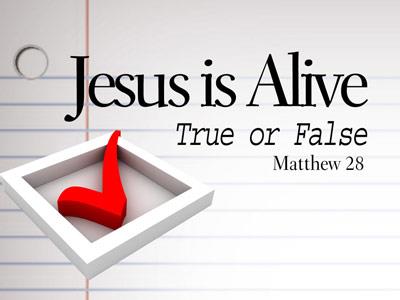-
Did Jesus Really Rise From The Dead? Series
Contributed by David Dewitt on Nov 28, 2017 (message contributor)
Summary: History and the Bible agree on the fact that Jesus was crucified until He was dead.
Did Jesus really rise from the dead?
The issue of the resurrection is the central reality for the faith of the church because without the resurrection there is no basis for faith. The reality is that there are many proofs for the resurrection that under gird and uphold the biblical teaching. So, let’s start with the biblical accounts of that first Easter Sunday.
1. Jesus was given an honorable burial
The gospels tell us that following the crucifixion, the body of Jesus was requested by Joseph of Arimethea for the purpose of burial. This shows that the Roman custom for leaving bodies on the cross was not followed for Jesus and that His body was removed from the cross.
1CO 15:3 For what I received I passed on to you as of first importance: that Christ died for our sins according to the Scriptures, 4 that he was buried, that he was raised on the third day according to the Scriptures,.
This earliest creed of the church attests to the fact that Jesus was buried as one of the foundational facts.
The burial preparation for Jesus would have included an anointing of the body, a wrapping of the body in strips of linen and a head cloth that would cover the face. This process would have revealed the fact that Jesus was dead because there would have been no way to prepare a body for burial and not know the person was dead.
2. The tomb where Jesus was buried was empty
The tomb was closed: The tomb had a large groove along the base with a large circular stone to close the entrance. The stone was rolled into place and became nearly impossible to remove
The tomb was sealed: The stone was then sealed by either clay or wax to further seal the entrance and make it air tight. The tomb of Jesus was also given the seal of the emperor and made it a capital crime to open the tomb.
The tomb was guarded: Pilate placed a large number of Roman soldiers to guard the tomb.
The tomb was also empty
There was no body – Jesus was gone
There was no disturbance – The linens for the burial were still there and in order and it could easily be seen that the body was not stolen
The burial cloth was folded upon itself. The burial cloth was used to cover the head of Jesus. This is literally impossible unless there was a miraculous removal of the body. This is one of the most striking evidences for the resurrection
3. Jesus was seen alive following His death on the cross
5 and that he appeared to Peter, and then to the Twelve. 6 After that, he appeared to more than five hundred of the brothers at the same time, most of whom are still living, though some have fallen asleep. 7 Then he appeared to James, then to all the apostles, 8 and last of all he appeared to me also, as to one abnormally born
Jesus was seen by many after the tomb was found to be empty. The fact that these witnesses supported the claims of the early church gives additional proof that Jesus had indeed been raised from the dead.
4. The disciples believed in the resurrection
The disciples were different people after the resurrection than they were before the resurrection. The night that Jesus was arrested they ran and hid themselves. Peter denied that he even knew Jesus. These men were craven cowards who wanted nothing more to do with following Jesus.
A little over a month after Jesus had died they left their homes, their occupations and their families and began to proclaim that He had risen from the dead. This caused a great deal of difficulty for them personally.
What made the change in these men? The answer is simple they had seen the risen Jesus and believed in Him. These same men that fled Jesus were now willing to suffer and die for Him. There is nothing else that could have changed them in such a way.
5. Jewish beliefs were radically changed
The Jewish people followed a system of beliefs that had been handed down for centuries and these beliefs were seen in five basic principles and none of these principles were held by the early church.
· The need for animal sacrifice
· The need for following the law given by Moses
· The worship on the Sabbath
· The belief in monotheism
· The picture of the Messiah as dying for the world
6. The conversion of skeptics
There is solid evidence that many of the Pharisees, a group that strongly opposed Jesus began to be converted into a personal faith in Christ. James the half brother of Jesus was also opposed to Jesus and His ministry but he too became a believer. The apostle Paul was one of the most aggressive and successful Pharisees who hunted down Christians and he became one of the greatest members of the early church.

 Sermon Central
Sermon Central



